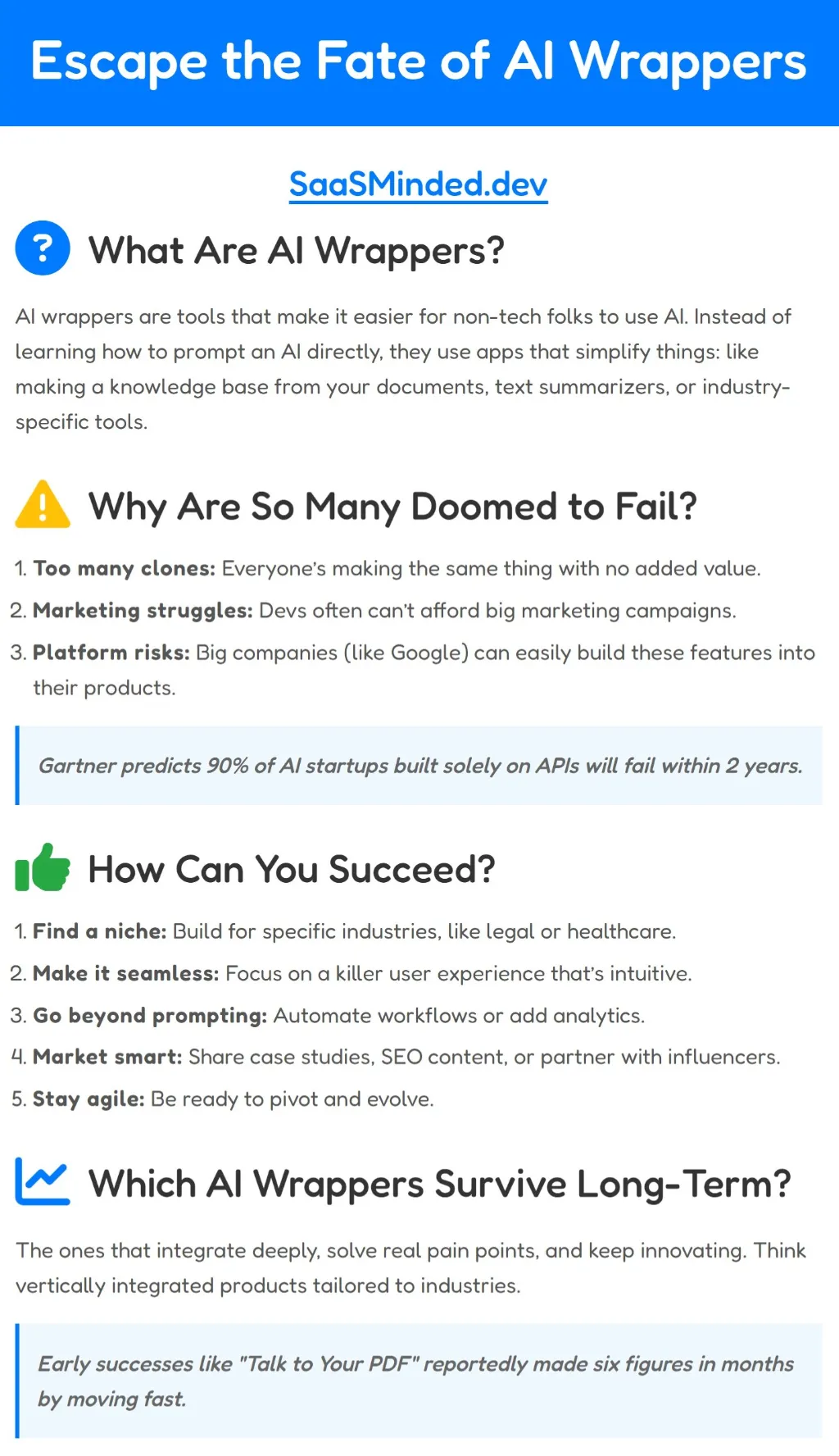With increasingly potent commercial and open-source models like OpenAI’s GPT and Meta’s LLaMA, solo entrepreneurs in the SaaS space are seizing the moment by creating AI “wrappers.” These innovative products essentially build user-friendly interfaces and specialized functionalities on top of existing, powerful AI models.
But, the crucial question looms: will these AI wrappers stand the test of time? Let’s analize this rapidly evolving market, and look at some practical guides solo entrepreneurs can use to succeed.

What Exactly Are AI Wrappers, and Why Are They So Popular?
AI wrappers are essentially specialized tools that provide custom-designed interfaces and target-specific applications for foundational AI models. Imagine needing to harness the power of a complex AI model. Instead of grappling with intricate prompts or APIs, wrappers simplify the entire process. They deliver a streamlined user experience, enabling even those without deep technical expertise to leverage the immense capabilities of AI.
Think of them as user-friendly gateways to powerful AI. They remove the technical barriers, making sophisticated AI accessible to a wider audience.
For instance, consider these examples that highlight the diverse applications of AI wrappers:
- Need to quickly understand a long document? "Talk to Your PDF" tools allow users to upload PDF documents and ask direct questions, extracting key information efficiently.
- Struggling to keep up with content creation? Text summarizers and transcription analyzers simplify these tasks for content creators, saving valuable time and effort.
- Looking for industry-specific solutions? AI wrappers are being tailored for specialized sectors like legal, healthcare, and marketing, addressing unique industry needs with precision.
The popularity of AI wrappers boils down to a straightforward reason: despite the raw power of advanced AI models, many individuals either lack the technical know-how to use them effectively or simply prefer an out-of-the-box solution that "just works." People want convenience and ease of use, and AI wrappers deliver exactly that.
Stat: According to a McKinsey report, "60% of business leaders cite ease of use as the top factor in adopting AI-powered tools." This statistic underscores the critical importance of user-friendliness in the adoption and success of AI solutions, a space where AI wrappers excel.
Why Are So Many AI Wrappers Considered "Born Dead" in the SaaS Market?
The SaaS market for AI wrappers is experiencing rapid growth, but this also means it's becoming increasingly crowded. A significant number of products are entering the market without clear differentiation, often merely relying on existing APIs. This creates a highly competitive and saturated environment, often described as a “sea of sameness.” In this crowded sea, numerous tools offer very similar basic functionalities, making it difficult for any single wrapper to truly stand out.
This lack of differentiation and the resulting intense competition are key reasons why many AI wrappers struggle to gain traction and are, in a sense, "born dead" in the market.
Let's break down the key reasons contributing to this high failure rate:
- Lack of Unique Value Proposition: A primary pitfall is that many wrappers fail to offer substantial improvements or unique features compared to readily available free tools or the underlying AI models themselves. If a wrapper doesn't offer a compelling reason to choose it over free alternatives, it will struggle to attract users.
- Ineffective Marketing Strategy: Solo developers, who often build these wrappers, frequently lack the necessary budget or marketing expertise to effectively reach their target audience. Even a brilliant product needs to be seen and understood by potential users, and without a solid marketing strategy, it can remain undiscovered. Think of it like opening a fantastic shop in a hidden alleyway – no one will find it!
- Platform Dependency and Risk: A significant vulnerability for AI wrappers is their reliance on foundational AI models. When these foundational models, like GPT or LLaMA, release similar features directly, wrapper products can quickly become irrelevant. Imagine building a business on a platform that suddenly starts offering your core service – it puts you in a precarious position.
Stat: A Gartner survey predicted that "90% of AI startups built solely on existing APIs will fail within two years." This stark prediction highlights the challenging landscape for AI wrappers and the urgent need for differentiation and strategic planning. It's a tough market out there, and survival requires more than just being first to market.
How Can Solo Entrepreneurs Make Their AI Wrappers Stand Out From the Crowd?
To avoid becoming just another face in the crowded AI wrapper market, solo entrepreneurs need to focus on strategic differentiation. Building a successful AI wrapper requires more than just wrapping an API; it demands innovation, user-centric design, and smart marketing.
Here are key strategies to help your AI wrapper stand out:
- Should You Target Niche Industries for Your AI Wrapper? Instead of creating generic, broadly applicable tools, consider focusing on industry-specific applications. Identify specific sectors where AI can address unique and pressing pain points. This targeted approach allows you to tailor your wrapper to the precise needs of a defined audience, making your product much more valuable to them.
- Example: Imagine a tool designed specifically for legal professionals. Instead of general text analysis, it could analyze contracts, automatically flagging potential legal risks and compliance issues. This specialized functionality is far more valuable to lawyers than a generic summarization tool.
- Actionable Tip: Don't guess what your target industry needs. Conduct direct interviews with professionals in your chosen industry. Ask them about their daily challenges, pain points, and unmet needs. This firsthand research is invaluable for identifying opportunities for AI-powered solutions.
- How Can You Radically Enhance the User Experience (UX) of Your AI Wrapper?A common downfall of many AI wrappers is that they are clunky, unintuitive, or simply difficult to use. Even if the underlying AI is powerful, a poor user experience can kill adoption rates. Focus on creating a seamless, enjoyable, and efficient user journey.
- Example: Strive for clean, intuitive dashboards with minimal setup requirements. Users should be able to quickly understand how to use your tool and achieve their desired outcomes without frustration. Think "Apple" simplicity rather than "complex software" complexity.
- Actionable Tip: User testing is crucial. Don't just assume your design is user-friendly. Test your product with real users from your target audience. Observe how they interact with it, gather their feedback, and iterate based on their experiences. User feedback is gold.
- Should Your AI Wrapper Go Beyond Simple Prompting to Offer More Value? Basic AI wrappers often simply provide a user-friendly interface for sending prompts to an AI model. To truly differentiate, aim to build features that deeply integrate with user workflows, offering automation, advanced analytics, or functionalities that extend far beyond simple prompting.
- Example: Consider a content generation tool. Instead of just generating text based on prompts, it could automatically schedule and post content to social media platforms, analyze content performance, and even suggest improvements based on data. This end-to-end solution offers significantly more value than just text generation.
- Actionable Tip: Map out the entire user journey for your target audience. Identify all the steps they take to accomplish a specific task. Look for opportunities to integrate your AI wrapper seamlessly into this workflow, automating steps, providing insights, and adding value at every stage.
- What's the Secret to Developing a Powerful Marketing Strategy for an AI Wrapper? Even the most innovative AI wrapper will fail if no one knows about it. A strong marketing strategy is not optional; it's essential. Especially for solo entrepreneurs with limited budgets, focusing on organic and cost-effective strategies is key.
- Example: Utilize content marketing, SEO (Search Engine Optimization), and strategic partnerships to build organic reach. Create valuable content, like blog posts, guides, and case studies, that address the pain points of your target audience and showcase how your AI wrapper provides solutions. Optimize your online presence for search engines so potential users can easily find you when searching for relevant solutions. Partner with complementary businesses or influencers in your niche to expand your reach.
- Actionable Tip: Show, don't just tell. Share compelling case studies that clearly demonstrate the tangible impact of your tool on real businesses or users. Quantify the benefits and showcase how your AI wrapper delivers results. Social proof is incredibly powerful.
How Can You Protect Your AI Wrapper Business From Platform Risks?
One of the most significant threats to AI wrappers is the inherent platform risk. Foundational AI model providers, like Google or OpenAI, may integrate key features directly into their platforms, potentially rendering many wrappers obsolete overnight. We've already seen examples of this, such as Google adding a text summarizer directly into Chrome. This highlights the vulnerability of businesses built on top of these platforms.
So, how can solo entrepreneurs mitigate these platform risks and build more resilient AI wrapper businesses?
- Is Continuous Innovation the Key to Surviving Platform Shifts? Standing still is not an option in the rapidly evolving AI landscape. Continuous innovation is crucial for staying ahead of the curve and adapting to platform changes. You can't just launch your wrapper and expect it to remain relevant forever.
- Actionable Tip: Maintain a dynamic product roadmap. Continuously plan for product improvements, new features, and adaptations based on market trends and platform developments. Regularly update your wrapper to offer new value and stay ahead of potential platform feature overlaps. Think of your product as a living, breathing entity that needs constant care and evolution.
- Should You Focus on Integration Rather Than Direct Competition with Major Platforms? Instead of trying to directly compete with major platforms, consider positioning your AI wrapper as a complementary tool that enhances their functionality. Focus on integration and interoperability with widely used platforms.
- Example: Develop plugins or integrations for popular SaaS platforms like Salesforce, Slack, or Microsoft Teams. By seamlessly integrating with these established platforms, your wrapper becomes a valuable add-on rather than a standalone competitor. This reduces the risk of being directly replaced by platform updates.
- Actionable Tip: Identify the major platforms your target audience already uses. Focus your development efforts on building integrations that make your AI wrapper an indispensable part of their existing workflows within these platforms.
- How Can Building Community and Brand Loyalty Offer Protection in a Volatile Market? Building a strong community around your AI wrapper and fostering genuine brand loyalty can provide a significant layer of protection against platform risks. Loyal users are more likely to stick with you even if foundational platforms offer similar features.
- Actionable Tip: Actively engage with your users. Create a community forum, a Slack channel, or a dedicated social media group where users can connect, share ideas, provide feedback, and support each other. Respond to user inquiries promptly and genuinely. Make your users feel valued and heard. A strong community creates a powerful moat around your business.
What Does "Make Hay While the Sun Shines" Mean for AI Entrepreneurs Right Now?
The AI wrapper market, while potentially temporary in its current form, presents significant and lucrative opportunities in the short term. Solo entrepreneurs who act quickly and strategically can generate substantial revenue and build a valuable foundation before the market inevitably consolidates and evolves.
The "make hay while the sun shines" adage is particularly relevant in this rapidly evolving landscape. The current window of opportunity might not last forever, so seizing the moment is crucial.
Why Are Short-Term Profits So Important in the AI Wrapper Space?
- Fuel for Future Ventures: Early profits generated from a successful AI wrapper can provide crucial capital to fund future projects, whether it's developing a more robust and sustainable AI product, pivoting to a related market, or investing in other entrepreneurial ventures. Think of it as seed money for your next big idea.
- Building Brand Equity and Trust: Gaining user trust and establishing a positive brand reputation early on is invaluable. Even if your initial AI wrapper evolves or pivots, the brand equity and user base you build can be leveraged for future endeavors. Trust is hard to earn and easy to lose, so prioritize building a strong and reputable brand from the outset.
Example: The founders of "Talk to Your PDF" reportedly made "six figures in just a few months" by effectively capitalizing on the early demand for their niche AI wrapper. This example illustrates the potential for rapid revenue generation in the current AI wrapper market.
Actionable Advice for Capitalizing on the Current AI Opportunity:
- Launch Fast and Iterate Based on User Feedback: Don't aim for perfection from day one. Launch a minimum viable product (MVP) quickly to test the market and gather real-world user feedback. Iterate rapidly based on this feedback, continuously improving your wrapper based on user needs and market demands. Speed is key in this fast-paced environment.
- Monetize Effectively from the Start: Don't delay monetization. Implement a clear and effective monetization strategy from the beginning, whether it's through subscription models, one-time payments, or a freemium approach. Generating revenue early is crucial for sustainability and growth.
- Prioritize Capturing User Emails and Building a Loyal Audience: Even if the AI wrapper market shifts, a loyal user base is a valuable asset. Focus on capturing user emails and building a strong relationship with your audience. This audience can be leveraged for future product launches, pivots, and long-term business growth. Your email list is your goldmine.
Will Any AI Wrappers Actually Survive Long-Term?
The AI wrapper landscape is dynamic, and while many may fade, some are undoubtedly positioned to survive and thrive in the long run. The key to long-term survival lies in deep integration, continuous innovation, and building lasting value beyond simply wrapping an API.
What Traits Will Define the Long-Term Survivors in the AI Wrapper Market?
- Vertical Integration and Specialization: AI wrappers that deeply solve complex, industry-specific problems and become indispensable tools within those verticals are more likely to endure. Generic wrappers will struggle, but highly specialized solutions addressing critical needs in specific industries have a much higher chance of long-term success.
- Strong Brand Loyalty and Community: Companies that successfully foster strong user relationships, build a loyal community, and create a positive brand experience will have a significant advantage. Brand loyalty creates resilience and reduces churn, even when faced with competitive pressures or platform changes.
- Agile Development and Adaptability: Founders and teams who are agile, adaptable, and willing to pivot and evolve with technological advancements will be best positioned to navigate the ever-changing AI landscape. The ability to anticipate future trends and adapt quickly is crucial for long-term survival.
Opinion: Just as history shows that only a small fraction of Web 1.0 startups survived to become tech giants, it's likely that only a handful of today’s AI wrappers will thrive in the long run. Think of these survivors as the potential “Googles” and “Amazons” of the AI era – companies that not only capitalized on the initial wave but also continuously innovated and adapted to become leaders in the long term.
Final Thoughts: Is Building an AI Wrapper a Smart Move for You?
If you're a solo entrepreneur in the SaaS space considering developing an AI wrapper, the answer is a cautiously optimistic yes. However, success isn't guaranteed, and a strategic approach is paramount.
Key Takeaways to Guide Your AI Wrapper Journey:
- Focus on Solving Real and Significant Problems: Don't just repackage existing AI features or create a "me-too" product. Identify genuine pain points and innovate to create a wrapper that offers unique and valuable solutions. Solve a real problem better than anyone else.
- Prioritize Effective Marketing and Audience Building: A great product is useless if no one knows about it. Invest in building an audience, communicating your product's value proposition clearly, and reaching your target market effectively. Marketing is not an afterthought; it's integral to success.
- Plan for the Future and Embrace Agility: The AI landscape is constantly shifting. Stay agile, continuously learn, and be prepared to pivot your product or business model as needed. Long-term success requires adaptability and a forward-thinking mindset.
The AI wrapper market may indeed be fleeting in its current form, but for those who execute thoughtfully, strategically, and with a focus on long-term value creation, it presents a compelling opportunity to build successful and potentially enduring businesses. Make hay while the sun shines, but always keep evolving to stay ahead of the curve and build a sustainable future.








